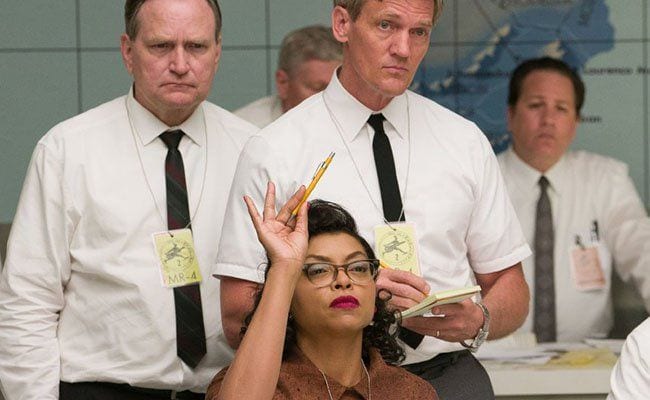
“Power was what mattered, and what characterized the differences between black and white America was not a difference in work ethic, but a system engineered to place one on top of the other.”
“Are you being disrespectful?” The white police officer eyes Mary (Janelle Monáe). “No sir,” she insists, “We’re on our way to work.” By “we” she means she and her friends, Dorothy (Olivia Spencer) and Katherine (Taraji P. Henson). Their car has broken down and Dorothy’s underneath it, in the midst of repairs, when the officer approaches them. When he hears that the work they’re on their way to do is at NASA’s Langley research center, where the mission is “getting our rocket into space”, he’s at first skeptical and then completely impressed. Within two deft editing beats, he’s giving them an escort to the facility, his cruiser’s siren sounding, so they won’t be late. Here’s something new, the friends agree: “Three Negro women are chasing a white police officer.” It’s 1961.
This early scene in Hidden Figures sums up the film’s focus and appeal. You may not have heard of these historical figures before, but as soon as you see them, you’re enchanted. It’s an effect conjured by familiar movie devices, including a set of rousing underdog stories, spirited performances by Henson, Spencer, and Monáe, a bit of romance, and all kinds of spunk. But as saccharine and comforting as these clichés may be, the film has a few other ideas on its mind.
Chief among these ideas is a connection between eras. While Hidden Figures is set in the past, the problems facing the human “computers” Mary, Dorothy, and Katherine still resonate for today’s viewers. A flashback shows young Katherine (Lidya Jewett) in grade school, dazzling her teacher and peers as she does calculations on the blackboard. The scene sets in motion the film’s animating insight, that Katherine sees what most other people cannot, visualizes the concrete effects of space and time, imagines what’s possible.
The movie delights in this imagining, inviting you to experience what she and her friends experience. When Mary appears before a Virginia judge, trying to convince him to allow her to enroll in a segregated physics class, we look up with her as he sits behind his big bench. You follow Dorothy into the vast white room where a giant new IBM machine sits idle, having baffled her white male coworkers; after hours, she trains herself to run it, so she can teach the other “colored computers” black women mathematicians under her supervision, so they can remain employed as the technology advances. As daunting as their views might look on a movie screen, you’re reminded that the real-life obstacles they faced must have loomed even larger.
You’re invited as well to share in multiple facets of Katherine’s experience, including her slowly developing courtship with Colonel Jim Johnson (Mahershala Ali): his first scene, in uniform at a picnic, has him expressing his surprise that a woman might be doing her sort of work, and she takes an appropriate movie-style moment to forgive him. The more prominent man in her storyline is the Space Task Group’s manager, Al Harrison (Kevin Costner), who’s so determined to ensure John Glenn’s (Glen Powell) successful orbit that he’s doesn’t much notice that Katherine’s black or female. He doesn’t much notice other issues either, whether this be her daily difficulties finding a “colored” bathroom to use (she has to run across the Langley campus in her heels, in the rain, while her coworkers judge her for what seem like extra-long lunch breaks) or her disparagement by the insecure and competitive Paul (Jim Parsons), a man who’s used to his American system, where her obvious gifts and skills can’t possibly outshine his.
We are wholly independent, with no corporate backers.
Simply whitelisting PopMatters is a show of support.
Thank you.
Al is initially impressed by Katherine when he sees her doing what you’ve seen her doing more than once, marking chalk figures on a blackboard. As she stands on a ladder, the image of Katherine here deliberately recalls the familiar trope of the pretty girl in a skirt that might allow for titillation. But she’s doing work, remarkable work that no one else can manage, work that frankly awes those watching her (reaction shots ensure you see this). And so her position, with the guys looking up at her, designates her power rather than vulnerability. Saying he doesn’t need “another smart girl with an adding machine”, Al finds in Katherine exactly what he wants, someone able to “look beyond the numbers, through the math that doesn’t yet exist.”
Using Katherine’s capacity to see as metaphor and a favorite plot point, Hidden Figures makes its own argument clear, underlining the difference between perception and blindness, bigotry and justice, right and wrong. Smart and sweet, the movie doesn’t so much press viewers to examine their own potential prejudices as it assumes the persuasive power of its own vision.


![Call for Papers: All Things Reconsidered [MUSIC] May-August 2024](https://www.popmatters.com/wp-content/uploads/2024/04/all-things-reconsidered-call-music-may-2024-720x380.jpg)



